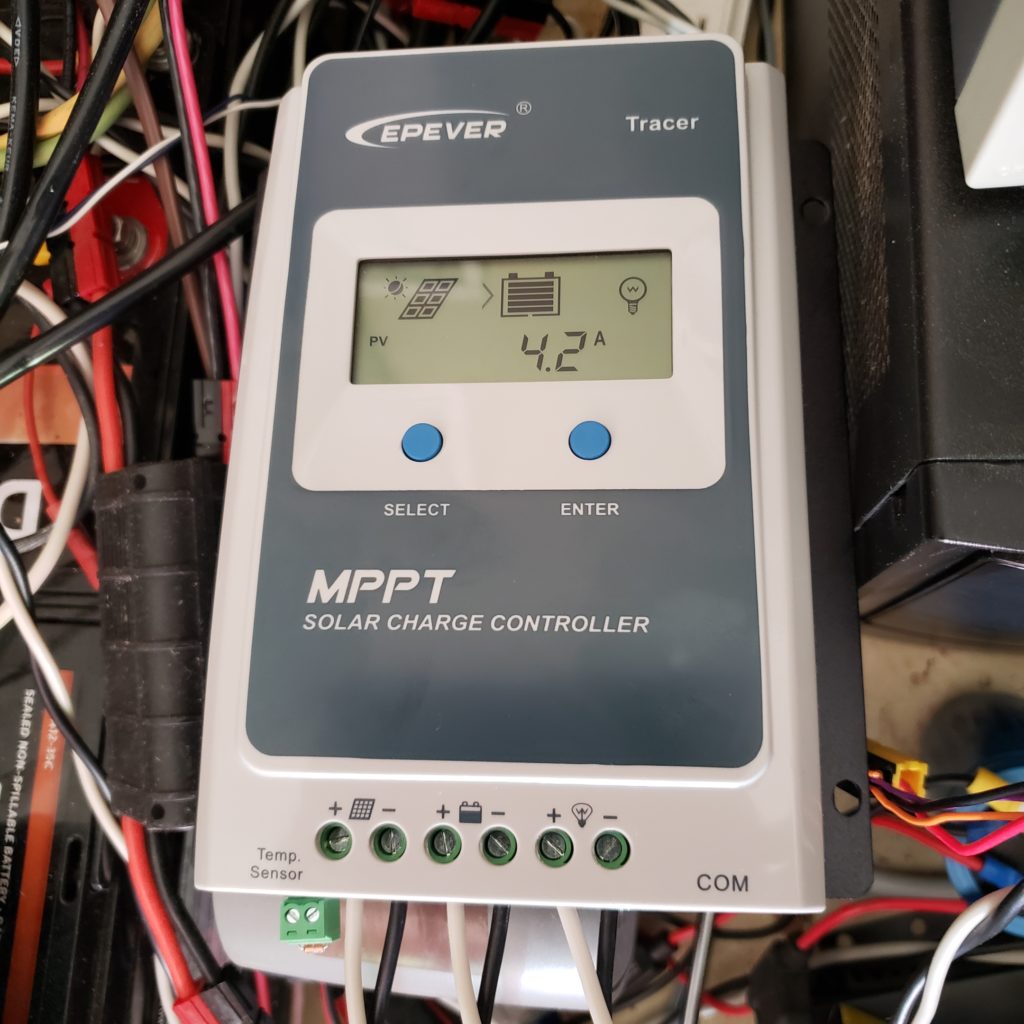I have toyed with the idea of having a genuine $1,300 Dancer brand solar powered refrigerator to pile the essentials into during an extended power outage. We currently don’t have any medicine or anything else out of the ordinary in our fridge that would warrant such an expensive purchase. The most important decision making task was to measure how much power our current fridge draws. In my case it was much smaller than I expected at 175 Watts. (It was also strange that the fridge had three 40W incandescent lights which drew almost as much power as the compressor.)
The compressor startup current (AKA Stalled Rotor Current to size the UPS), the defrost cycle heater and the normal duty cycle of the compressor to size the battery bank and define solar requirements. The single most expensive purchase was the Triplite SU1000XLA UPS at about $600 New. It had sufficient surge capacity to start the compressor and an external battery connection to keep it running all day.

The original wires were about a foot long, but I needed longer wires to reach the batteries on the floor. Knowing I have multiple batteries and multiple wires I can extend the wires quite a bit and keep the same impedance. Startup current is 700W and that’s 35A so three banks with 10A fuses was insufficient to carry the 3x12A needed by the refrigerator. 30A across one foot of 12AWG has a voltage drop of 0.0477 Volts and five parallel wires @ 5Ft long are the same resistance. (1.4W) The advantage of NOT connecting the batteries together at the batteries is it allows some variance in performance between manufacturers and the batteries age. (I didn’t buy $1,000.00 worth of batteries at one time.) Battery to battery is 20Ft of 12AWG wire which is .0318 Ohms and at just 10A allows 0.32 V difference between the batteries. (Preventing the strong batteries from taking more than their share of the load.) The startup current is just 7A per battery with five and just under 9A for four batteries. If a single battery shorts out, the 10A fuse connecting the two batteries will isolate it. With five banks fused at 10A that will provide 50A with 1.75KWH capacity to the UPS for about 20 hours with new batteries.
Next on the list was a storage battery capable to run the fridge for 24 hrs. I used 175W x 24 (Hours) x .5 (Duty Cycle) =2100WH.

Actual usage is 2370WH / 24V * 1.2 (Efficiency) * 2 (50% discharge) = 237AH of battery. (12V 100AH AGM batteries are roughly $250 each) To keep it running 24Hours/Day we need to recharge the batteries AND provide running power during the day.
Each 100W panel produces 350WH/Day on average so I need at least Five 100W panels. Three of them will be charging the battery and two to run the refrigerator during the day (Need 3x panels during the winter.). If we loose power because of a storm, I’ll have to run a tiny 600VA 20lb generator twice a day for 5 hours to recharge the batteries. (~1Gl gas/Day) until the sun comes back out.
Two panels will likely cover most of the long term outages we have around here with 1500WH of Solar power for two days and more than 5880WH of stored power. The last item on the list is the Solar Charge Controller which provides accurate battery voltages to protect them.

Because of the current situation with the COVID-19 we bought a DC powered freezer which can also be used as a fridge.

The good thing is that it is dual powered (AC/Battery) and draws about 85W half what our fridge in the kitchen draws. 85W x 6.9 Hours x 30 Days is $2.11/Month in Fridge mode and 85W x 10.8 Hours x 30 Days = $3.31 in Freezer mode. (Calculated) On battery it will consume 76AH/Day in Freezer mode. My solar panels generate about 1.5KW/Day and the Fridge consumes 918WH/Day in freezer mode. The solar panels generate power for 5 hours/Day so 19 Hours/Day will be on battery. 80% efficiency for round trip to battery and back for 19 hours will use 8.5H x 85W x 120% = 872W / Day on Battery during a sunny day and 1100WH on a cloudy day. Charge Amps for 872WH / 5 hours = 15A minimum into the battery during daylight. Storage needs to be 2 cloudy days x 50% battery discharge 4400 WH = 366AH (10 x 35AH battery) Required storage for AGM charge at 15 Amps is 150AH minimum.

After having the refrigerator for two years I finally put a temp sensor inside it. I was shocked how a warm bottle of water affected the inside temperatures. Now I am wondering if it matters where inside the fridge the warm water is placed.